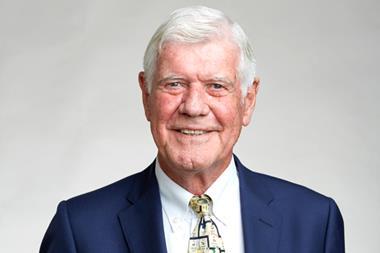Chemistry collector’s edition and the way to Ytterby
Judge a book by its cover
The cover of the book Safe science caught my eye. How often we see pictures, obviously staged, to illustrate a safe situation in a working laboratory environment and how easy it is for the casual observer to identify faults in these interpretations of best practice.
I was not disappointed here: a large reaction is being magnetically stirred without secondary containment; the sash is too high; the hair not tied back. Need I go on?
All this reminds me of when I was part of an interview panel for a health and safety officer position in which a candidate had included photographs of lab scenes to illustrate the levels of good practice that they had introduced in their current role.Each had more glaring errors than I have highlighted above. Needless to say, the candidate was unsuccessful.
Come on folks, if you are trying convey optimal health and safety practices, then get a few opinions before going to print.
Ian Clemens FRSC
West Sussex, UK
Collector’s edition
I suspect that most retired chemists have garages and sheds that are, effectively, unofficial chemical museums. I constantly add to mine – my main focus being items relating to pest control.
As a regular attendee at antique fairs, I am amazed at the variety of items that can be found, and my wife, who could be faced with the question of what to do with the stuff if I pre-decease her, would be delighted if there was a chemical museum to which these items could be donated.
My collection includes the ubiquitous DDT fly sprays, which pre-date aerosols, DDT puffer packs for ants, insecticidal furniture polish, white phosphorus rat poison, and my favourite, 10% DDT louse powder.
I use this last item as a visual aid during tours of Canterbury cathedral, which I have been conducting for many years. If we talk about medieval hygiene, it often helps to get a volunteer to read the instructions out loud to the group:
‘For body lice, dust entire inner surface of undergarments, especially seams, also inner seams of trousers and shirt. Rub treated areas lightly by hand to spread powder evenly. Repeat at least every month and following each change of clothing. For pubic (crab) lice, apply to all regions of the body where coarse hair is present. Repeat after one and two weeks.’
I have yet to find a volunteer who can get past the last bit without bursting into a fit of laughter.
Michael Baldwin FRSC
Kent, UK
Set for success
I would like to add some of my own reminiscences to Nigel Jopson’s letter.
When I first became interested in chemistry, as a secondary schoolboy in the 1940s, I soon dismissed the chemistry sets on sale in local toyshops. Instead I set about assembling my own home laboratory. I do remember Beck’s of Stoke Newington – at the time they offered a range of chemicals, supplied in small, corked glass bottles all at 4½d each (the content varying according to the unit cost of the contained material), as well as some simple glassware and other items.
My main source of inspiration, however, was a small, paperback book: Simple home chemistry for boys by E A Rudge. This excellent book described how one could assemble a ‘usable’ home laboratory from common household items as well as purchased labware. Experiments included the preparation of hydrogen using ‘accumulator’ (dilute sulfuric) acid (from a local garage), and cut-up torch battery casings (zinc), and the electrolysis of water in a cell made from an ice-cream tub and carbon rods, again from spent torch batteries.
The book also included a list of materials suppliers, and pages of printed labels for your assembled reagent bottles.
Derek Palmer CChem MRSC
Woking, UK
I greatly enjoyed the article ‘All set for chemistry’.
As another whose chemistry career started with a home chemistry lab and Gilbert chemistry set, I would add a footnote regarding the amazing A E Gilbert. He was a graduate of the Yale Medical School (but never practised), won a gold medal in the pole vault in the 1908 Olympics in London and was the inventor and manufacturer of the well-known Erector set.
Truly a Renaissance man.
Howard Peters FRSC
California, US
Recent articles on chemistry sets and chemical museums have caused me to reflect upon my own background and the chemical pleasures of my youth.
As a lad I was fascinated by the sciences, particularly chemistry and physics, and I too received chemistry sets as gifts. I supplemented these with wires from old valve radios, carbon rods from batteries etc. I wonder how many readers remember the huge zinc–carbon batteries used with old radios? I augmented my precious supply with items from local pharmacies: sulfur, magnesium ribbon, iron filings, granulated zinc, potassium nitrate, potassium permanganate – these were usually supplied in old cardboard pill-boxes. I even purchased concentrated hydrochloric acid which I carried home in a screw-topped glass bottle in my blazer pocket!
I also ordered gas jars, a beehive shelf and pipette and burette from mail order companies. I was partly guided in my purchases by the admirable books Chemistry experiments at home for boys and girls by H L Heys and a similar physics one by T H Savory, both of which I still have to this day.
In retrospect I was very fortunate to survive to adulthood after exploding large amounts of hydrogen–oxygen and acetylene–oxygen mixtures. Needless to say my long-suffering mother came running down to the cellar more than once as the whole house shook!
I still have a great passion for my subject and although I retired 13 years ago, I still do some voluntary teaching at a local primary school and I have staged a number of chemistry demonstrations. It is a joy to see the wonder and excitement in children’s faces when they see live experiments for the first time.
David Stokes CChem MRSC
Swansea, UK
What is science?
Colleagues may be aware of the long standing parliamentary links scheme, previously organised by Stephen Benn. Aspects of this scheme have now followed Benn to the Society of Biology. The recent meeting on 23 June at Portcullis House was attended by over 200 members of some 20 scientific societies and also by members of the Houses of Commons and Lords.
In response to two of the presentations, which referred to the significance of the social sciences, I referred to an earlier statement by John Bercow when welcoming German Chancellor Angela Merkel to address MPs and peers in February 2014, which I heard on the radio at the time: ‘It is unusual for MPs to have doctorates,’ he said. ‘And those MPs with doctorates have them in social sciences. But Merkel’s is in a hard science.’
Christie Davies, then professor of sociology of at the University of Reading, made an interesting comment in the Sunday Times on 21 February 1995: ‘To rob a word of its meaning, all that is needed is to add “social” to it.’ Bercow’s comment on ‘hard science’ is a reminder of recent observations yielding molecular information from solar and extra-solar planets that is consistent with our observations on planet Earth. By contrast, the social sciences draw on local information that is absent or unlikely to exist elsewhere in the universe.
Bill George FRSC
Pontypridd, UK
More on Moseley
Gordon Woods is quite correct to draw attention to the fact that many textbooks misleadingly encourage the belief that Henry Moseley ‘discovered atomic number’.
Until the early years of the 20th century, the periodic table was an array of the elements arranged in order of increasing relative atomic mass; however, there had to be some fudging. Thus tellurium is placed before iodine, despite having the higher atomic mass.
A Dutch lawyer and amateur scientist, Antonius van den Broek, speculated in 1912 that ‘if all elements be arranged in order of increasing atomic weights, the number of each element in that series must be equal to its intra-atomic charge’.
Moseley was quite aware of van den Broek’s suggestion of ‘atomic number’ and indeed paid tribute to him in a letter to Nature in 1914 for acting as a catalyst for his x-ray diffraction work: ‘which was undertaken for the express purpose of testing Broek’s hypothesis’. Ernest Rutherford was less than pleased at the credit being given to the Dutchman and expressed annoyance ‘that a layman should publish a lot of guesses for fun, without sufficient foundation’.
This is not to belittle Moseley’s contribution to atomic number. Perhaps the distinguished historian of chemistry, James Partington, should have the last word: ‘Van den Broek’s hypothesis … was doubtless in the minds of others at the time, but the credit for its publication belongs exclusively to him. The credit for its experimental verification (1913–14) belongs exclusively to H G J Moseley’.
Alan Dronsfield FRSC
Historical Group, Royal Society of Chemistry
Do you know the way to Ytterby?
I have long wanted to visit the Swedish village of Ytterby on the island of Resarö, where four elements were discovered, to see its famous mine. I finally did so this year.
Finding directions to the mine itself, however, is like finding hens’ teeth. My saviours were Mark Saxon and Magnus Leijd of Tasman Metals, the company that owns the mine.
I am sure that I am not the only one who has felt the desire to visit this historic location, so here are the directions:
- Go to Stockholm
- The ferry office is opposite the Grand Hotel
- Catch the ferry to Ytterby (checking with the ferry employee that it does, indeed, go to Ytterby; cost is SEK150 (£11), SEK100 for OAPs)
- Relax and watch the awesome scenery for 90 minutes
- Get off at Ytterby, walk forward 20 yards and turn left
- Follow the road around the right handed bend until you see two rocks on the right (you’ll see them on one of the many videos about the mine). It’s about 200 yards.
- You’ve arrived – get climbing those steps
Jeff Jones CChem MRSC
Moray, UK












No comments yet